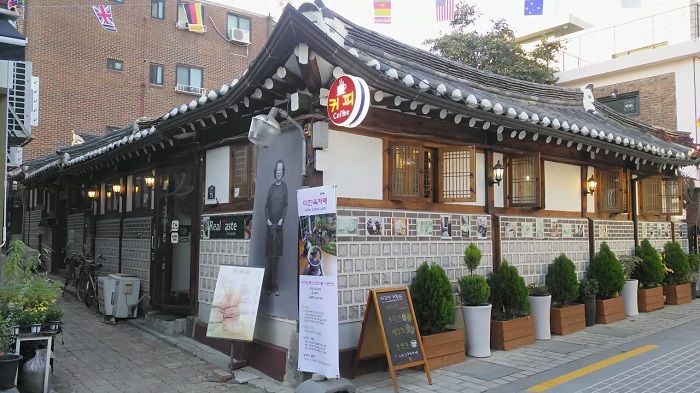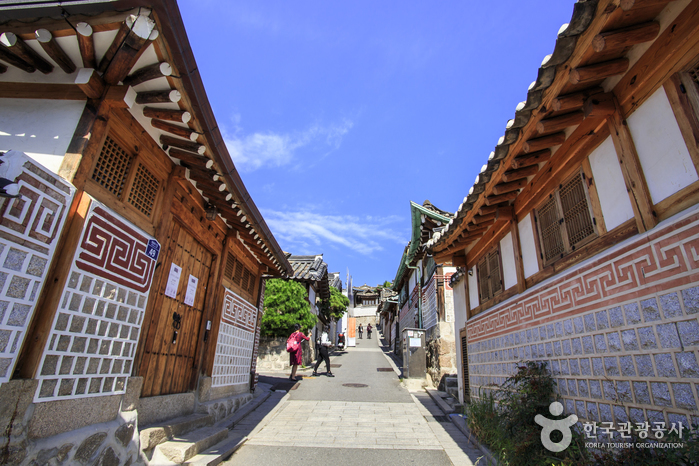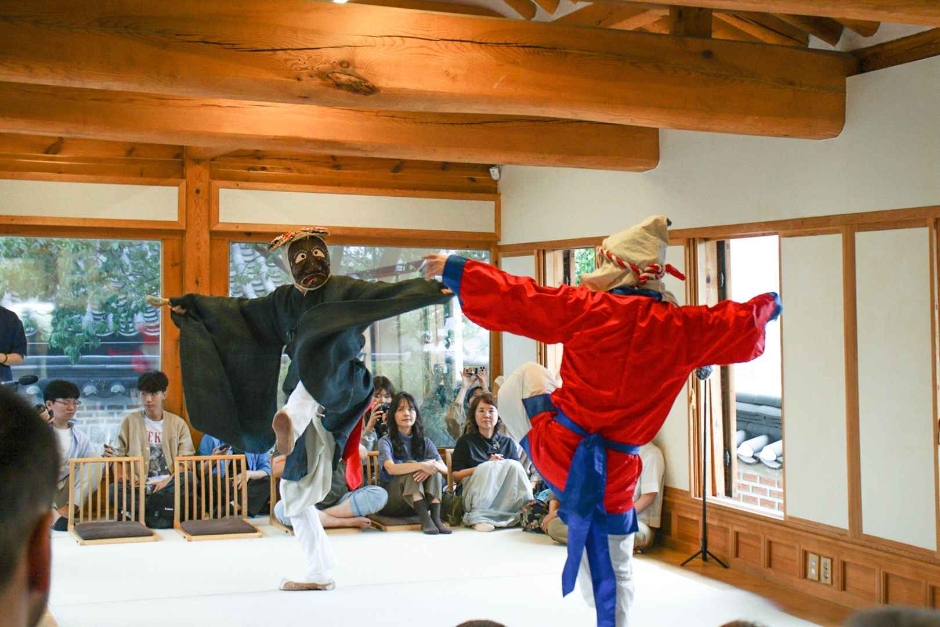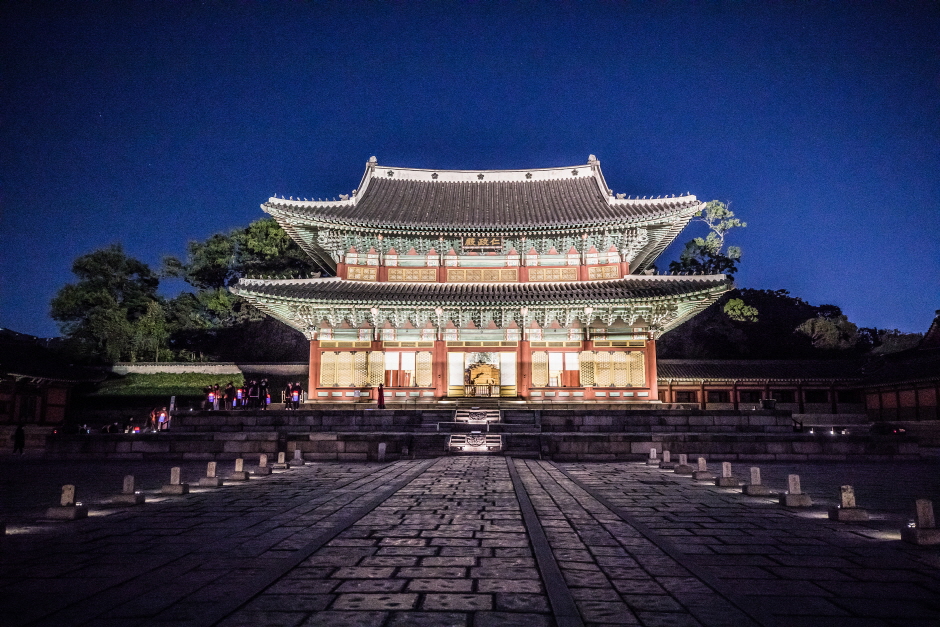The Hanok (더 한옥)
553.1825057203896m 78 2021-03-24
75, Gyedong-gil, Jongno-gu, Seoul
+82-2-743-7470
You can enjoy coffee in a hanok (Korean house). This restaurant's signature menu is coffee. This cafe is located in Jongno-gu, Seoul.
Bukchon Hanok Village (북촌한옥마을)
556.3083216249257m 1026638 2024-05-17
37, Gyedong-gil, Jongno-gu, Seoul
+82-2-2148-4161
Surrounded by Gyeongbokgung Palace, Changdeokgung Palace and Jongmyo Shrine, Bukchon Hanok Village is home to hundreds of traditional houses, called hanok, that date back to the Joseon dynasty. The name Bukchon, which literally translates to "northern village," came about as the neighborhood lies north of two significant Seoul landmarks, Cheonggyecheon Stream and Jongno. Today, many of these hanoks operate as cultural centers, guesthouses, restaurants and tea houses, providing visitors with an opportunity to experience, learn and immerse themselves in traditional Korean culture. As Bukchon Hanok Village is an actual neighborhood with people's homes, visitors are advised to be respectful at all times while looking around.
Seoul Public Hanok Week (공공한옥주간)
583.8132218167764m 0 2024-05-24
37 Gyedong-gil, Jongno-gu, Seoul
+82-2-741-1033
The Seoul Public Hanok Week offers a full week of traditional culture at public hanok, traditional Korean buildings, throughout Seoul and Bukchon Hanok Village. Experience the beauty, charm, and history of these buildings while learning about the eco-friendly impact of their construction and methods to apply this to our modern lives.
121 Bukchon [Korea Quality] 121북촌 [한국관광 품질인증]
597.0168349470475m 3 2023-05-23
121, Gyedong-gil, Jongno-gu, Seoul
+82-507-1358-3701
121 Bukchon is a foreigner-only guesthouse in the heart of Bukchon Hanok Village in Jeongno-gu, Seoul. Public transportation links are good, with Exit 3 of Anguk Subway Station just a seven-minute walk away. The house has a fine view over Bukchon Hanok Village, and early-rising guests will also catch the sunrise in the south-eastern sky. The guesthouse is decorated with art works and Joseon-period antiques. An American-style breakfast is served in the morning.
Olive Young - Anguk Branch [Tax Refund Shop] (올리브영 안국)
599.8724779360431m 0 2024-04-17
1F, 45, Yulgok-ro, Jongno-gu, Seoul
-
Moonlight Tour at Changdeokgung Palace (창덕궁 달빛기행)
617.1965452864991m 61620 2023-09-07
99, Yulgok-ro, Jongno-gu, Seoul
+82-2-1522-2295
The Moonlight Tour at Changdeokgung Palace is a high-quality cultural event held at Changdeokgung Palace, a UNESCO World Heritage. The tour offers a unique opportunity to witness and experience palatial beauty under the moonlight.
Gwanghwamun Gate (광화문)
619.0210953584478m 154063 2022-12-14
161, Sajik-ro, Jongno-gu, Seoul
+82-2-3700-3900
Built in 1395 under the reign of King Taejo, the first king of the Joseon dynasty, Gwanghwamun Gate is the southern gate of Gyeongbokgung Palace. It is also the main gate of the palace, therefore larger and fancier in comparison to the other gates. Gwanghwamun Gate consists of three arched gates; the center gate was used by the king, while the other two were used by the crown prince and royal officials. The tall granite walls of the gate serve as a platform for the wooden gate tower that watches over the city. The gate has a sign with its name written at the top center of the gate tower.
Gwanghwamun Gate went through several damages and restorations over the course of history. It was first severely damaged during the Imjin War (1592-1598) and was not restored until the reconstruction of Gyeongbokgung Palace in 1864. Under the Japanese administration, the gate was demolished and relocated to the north of the palace's eastern gate, followed by series of damages during the Korean War (1950-1953). In 1968, Gwanghwamun Gate was relocated back to the south of the palace and was rebuilt using concrete; however, the gate’s position was shifted a few meters away from its original location. In 2006, a major reconstruction project took place to restore Gwanghwamun Gate to its original state and location, disassembling the structure completely and replacing concrete with granite and wood. After three years and eight months of construction, Gwanghwamun Gate was fully restored to its original form and was open to the public on August 15, 2010.
Inwoohouse [Korea Quality] / 인우하우스 [한국관광 품질인증]
619.7328751256686m 34544 2023-09-12
1-9 , Gyedong 6-gil, Jongno-gu, Seoul
+82-2-742-1115
Inwoo House is a traditional hanok down an alley in Gye-dong, Jongno, Seoul. There is a swallow's nest under the eaves, and the pride of this house is that the swallow family returns every spring. Each room in the house has a private bathroom. Residents can sample Korean culture by taking part in traditional paper crafts, knot bracelet making, and fan decorating. The location is convenient for restaurants, cafes, and convenience stores, and Gyeongbokgung Palace, Changdeokgung Palace, Insadong, and Samcheong-dong are all within walking distance.
The Place Seoul (traditional Korean-style guesthouse) [Korea Quality] / 멀티스페이스 곳 [한국관광 품질인증]
619.459984577369m 601 2019-12-05
52-11, Gyedong-gil, Jongno-gu, Seoul
+82-10-3255-1289
“The Place Seoul” is located in a small alley in Gyedong-gil, Jongno-gu, Seoul. It is a guesthouse made by remodeling an 80-year-old traditional Korean house. The ondol room furnished with traditional beddings is popular not only among foreigners but also among Koreans due to its special ambience. The ceiling of the room dates back to 80 years ago. The rafter put on the roof at the time of construction of the house shows the antiqueness of the house. The toenmaru (a narrow wooden porch running along the outside of a room) that comes alive with the frequent coming and going of people adds to the ambience of the traditional Korean house, with the Sansuyu (corni) tree and vegetable garden beside the Korean-style house creating a leisurely atmosphere.
Beyond being a mere place to sleep in, “The Place Seoul” aims to be a composite cultural space whose motto is “the place to fill.” A simple wedding or a small-scale performance is held in the garden during the day. The rooms can be rented for small meetings.
“The Place Seoul” sponsors “WWOOF KOREA,” an NGO promoting environment-friendly agriculture as well as the right dietary life, “Slow Food Korea,” and “Slow Box.” As such, the place serves a special healthy breakfast consisting of homemade bread, handmade yogurt, and organic fruits and vegetables. In addition, the toilet paper, detergent, shampoo, etc. provided are all environment-friendly products.
“The Place Seoul” is located on Gyedong-gil Road, a famous tourist attraction in Seoul. It offers easy access to Bukchon Hanok Village, which is on the other side of the Gyedong-gil alley, as well as other major tourist attractions within walking distance including Changdeokgung Palace, Gyeongbokgung Palace, Samcheong-dong, and Insa-dong. The convenient location of “The Place Seoul” makes it easy to tour downtown Seoul.
Seoureseo Duljjaero Jalhaneunjip (서울서둘째로잘하는집)
623.7388520678368m 20742 2024-03-15
122-1 Samcheong-ro, Jongno-gu, Seoul
+82-2-734-5302
Seoureseo Duljjaero Jalhaneunjip is a sweet red bean porridge and traditional tea house near Gyeongbokgung Palace. Sweet red bean porridge is a sweet and smooth dish typically containing chewy rice cakes and chestnuts. In Korea, it's a traditional food eaten during dongji (the shortest day and longest night of the year). They also offer traditional teas like ssanghwatang (herbal tonic tea), which contains seven medicinal herbs, sujeonggwa (cinnamon punch) with a blend of cinnamon and ginger flavors, and sikhye (sweet rice punch), a drink known for aiding digestion.




![Olive Young - Anguk Branch [Tax Refund Shop] (올리브영 안국)](http://tong.visitkorea.or.kr/cms/resource/84/2878484_image2_1.jpg)

![Inwoohouse [Korea Quality] / 인우하우스 [한국관광 품질인증]](http://tong.visitkorea.or.kr/cms/resource/56/3009456_image2_1.jpg)
![The Place Seoul (traditional Korean-style guesthouse) [Korea Quality] / 멀티스페이스 곳 [한국관광 품질인증]](http://tong.visitkorea.or.kr/cms/resource/68/2631068_image2_1.jpg)
 English
English
 한국어
한국어 日本語
日本語 中文(简体)
中文(简体) Deutsch
Deutsch Français
Français Español
Español Русский
Русский